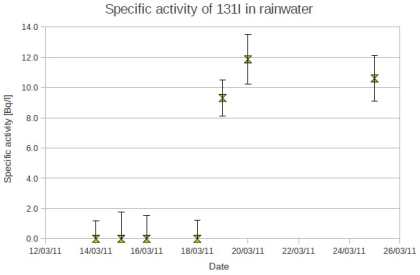Simon Fraser University researchers are attributing increased levels of the radioisotope iodine-131 in B.C. seaweed and rainwater samples to the Fukushima Dai-Ichi nuclear reactor situation in Japan.
Japanese officials have been working to prevent a nuclear meltdown after cooling systems failed following a magnitude 9.0 earthquake earlier this month that was accompanied by a tsunami. Medical and pharmaceutical industries use iodine-131; it’s also present in nuclear fission products.
SFU nuclear scientist Kris Starosta is confident Fukushima is responsible for the recent discovery.
The jet stream is carrying the radiation from Japan to North America. Most of the radioactivity disperses in the atmosphere and falls over the Pacific Ocean on its way over, but some of it has now reached the west coast, falling down with rain, and mixing with seawater. It’s also accumulating in seaweed.
The rainwater tested was collected at SFU’s campus on Burnaby Mountain and in downtown Vancouver, while seaweed samples were collected in North Vancouver near the Seabus terminal. Researchers began monitoring rainwater earlier this month but did not see the signature for iodine-131 in samples taken March 16 and March 18. However, they did detect the radioisotope’s signature in samples from March 19, 20 and 25.
Here are the results from the tests (measured in decays of iodine-131 per second per litre of rainwater – Bq/l):
March 18: 0 (2) Bq/l
March 19: 9 (2) Bq/l
March 20: 12 (2) Bq/l
March 25: 11 (2) Bq/l
“The only possible source of iodine-131 in the atmosphere is a release from a nuclear fission,” says Starosta. “Iodine-131 has a half life of eight days, thus we conclude the only possible release which could happen is from the Fukushima incident.”
Starosta and his team of SFU researchers – Rachel Ashley, Aaron Chester, Svetlana Avramova and Ken Myrtle – will continue monitoring iodine-131 levels. Seaweed samples taken from Barkley Sound on Vancouver Island’s west coast are also being tested. Starosta predicts iodine-131 will be detected in B.C. 3-4 weeks after the Fukushima nuclear reactor stops releasing radioactivity into the atmosphere. These number represent Iodine levels reaching the North American west coast as 100 Times Over US ‘Safe’ Limit for drinking water.
[youtube BLlXfB_GxMg nolink]










